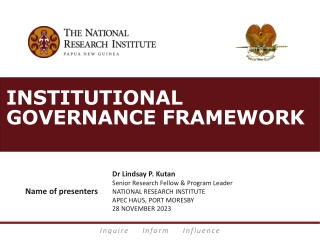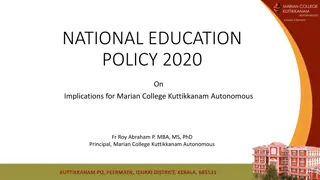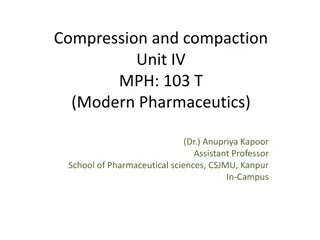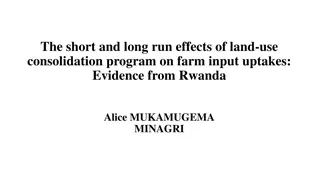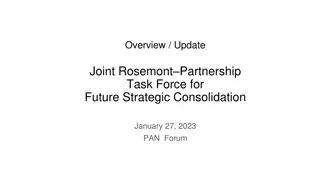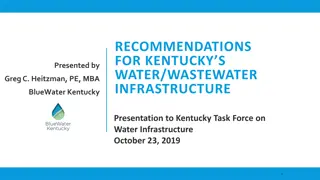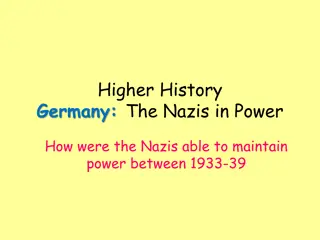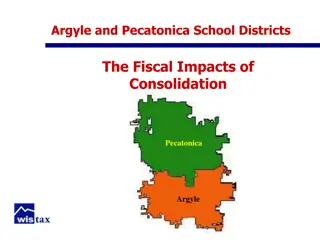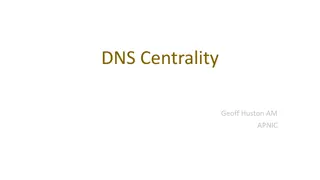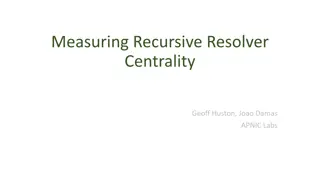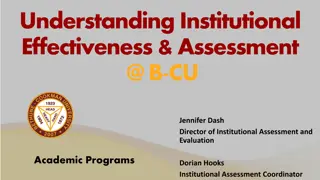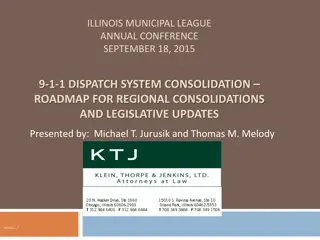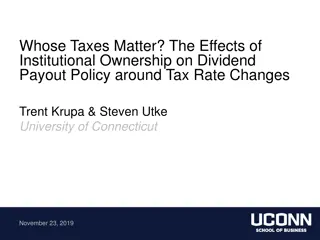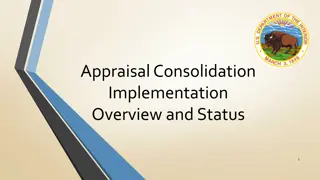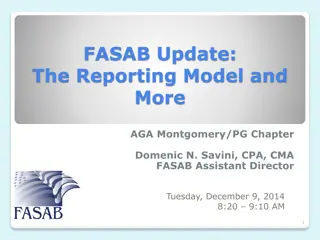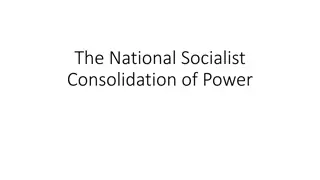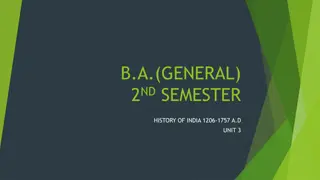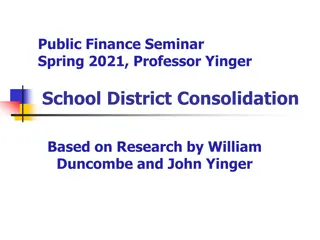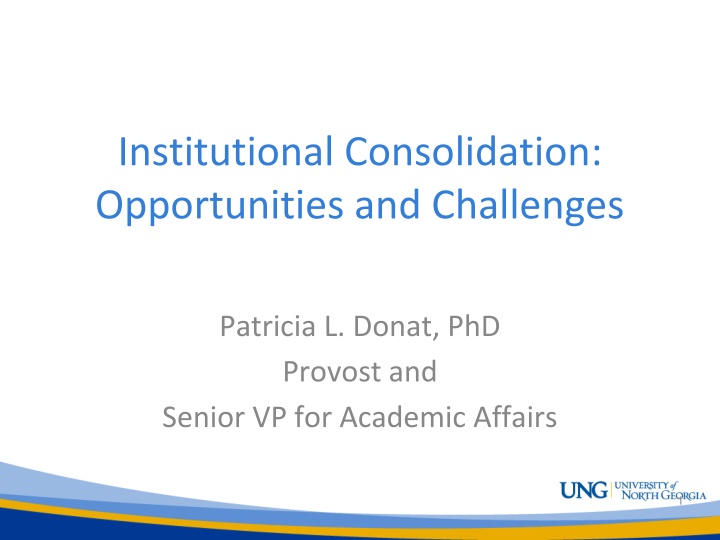
Challenges and Opportunities in Institutional Consolidation
The discussion revolves around the economic, educational, and operational factors influencing the consolidation of educational institutions, specifically focusing on the context, principles, timeline, opportunities, and challenges faced by the UNG Consolidation. It highlights the need for efficient operations, economic development, and enhanced education accessibility while addressing challenges related to differences in institutional type, mission, and demographics.
Download Presentation

Please find below an Image/Link to download the presentation.
The content on the website is provided AS IS for your information and personal use only. It may not be sold, licensed, or shared on other websites without obtaining consent from the author. If you encounter any issues during the download, it is possible that the publisher has removed the file from their server.
You are allowed to download the files provided on this website for personal or commercial use, subject to the condition that they are used lawfully. All files are the property of their respective owners.
The content on the website is provided AS IS for your information and personal use only. It may not be sold, licensed, or shared on other websites without obtaining consent from the author.
E N D
Presentation Transcript
Institutional Consolidation: Opportunities and Challenges Patricia L. Donat, PhD Provost and Senior VP for Academic Affairs 1
Context for Consolidation Economic recession Sustained reduction in state appropriations Repeated calls for more cost-efficient operations of state agencies Consolidation of Georgia technical colleges State and federal concerns about rising tuition Complete College America initiative to increase post- secondary educational attainment 2
Principles for Assessing Potential for Consolidation Increase opportunities to raise education attainment levels Improve accessibility, regional identity, and compatibility Avoid duplication of academic programs while optimizing access to instruction Create significant potential for economies of scale and scope Enhance regional economic development Streamline administrative services while maintaining or improving service level and quality 3
Consolidation Timeline Driven by SACSCOC, US Dept of Ed, and IT deadlines 2012 Jan: Consolidation announced Feb: Consolidation Implementation Committee formed Mar: Executive Planning Team & Workgroups formed May: Board approval of name and mission Oct: Substantive Change Prospectus due to SACSCOC Dec: Vote by SACSCOC Board of Trustees on Prospectus 2013 Jan: Official date of consolidation Mar: Computing systems consolidated for fall registration Aug: Fully implement consolidation Sept: SACSCOC site visit 4
Opportunities for the UNG Consolidation 15,000 student institution to meet higher education needs of NE Georgia Broad array of programs (certificate doctoral) Expanded higher ed access to fast-growing area Limited growth potential for Dahlonega and Oconee campuses; consolidation provided additional capacity Strong foundation of partnership and collaboration between the institutions Economies of scale 5
Challenges for the UNG Consolidation: Differences in Institutional Type, Mission, and Demographics
Gainesville State College North Georgia Coll & State Univ Established 1966 1873 SACSCOC Level II V Admissions Access Selective Enrollment 8,700 6,500 Residential No 30% Residential 1st Yr Retention 61.4% 79.9% Graduation 11.7% (3-yr) 49.2% (6 yr) Fy13 E&G Budget $45.6 million $51.7 million FT Faculty (PT) 200 (190) 250 (125) FT Staff (PT) 225 (30) 420 (20) 7
Challenges for the UNG Consolidation Different cultures (mission, history) Different admission standards and tuition Different student populations Different promotion and tenure requirements Different versions of Banner Different governance structures Different accounting and budget practices 8
Strategies for the UNG Consolidation: Priorities for Implementation
Consolidated Name and Mission Statement The University of North Georgia, a regional multi- campus institution and premier senior military college, provides a culture of academic excellence in a student- focused environment that includes quality education, service, inquiry and creativity. This is accomplished through broad access to comprehensive academic and co-curricular programs that develop students into leaders for a diverse and global society. The University of North Georgia is a University System of Georgia leadership institution and is The Military College of Georgia. 10
Institutional Organization and Governance Establish organizational structures Name senior leadership and complete organizational charts Draft essential governing documents University statutes Statutory committees 11
Structures for Collaborative Decision-Making Consolidation Implementation Committee Executive Planning Team Coordinating Groups Workgroups Faculty workload and compensation Academic policies: Students Student code of conduct Institutional tuition and fees Awards, rituals, and ceremonies 12
Communication and Leader Visibility Disseminate information as soon as decisions are available. In the absence of information, people make it up. People have a low tolerance for uncertainty. Celebrate good news. Use multiple modes of communication. Website Presidential consolidation updates Email Co-authored communications Video teleconference Group and individual meetings 13
Important Concepts to Remember Consolidation is a process not an event. Change is difficult for everyone. Trust is built slowly and even once earned will be tested for confirmation. Institutional identity and group membership are foundational to personal identity.
Monitor Assumptions Avoid assumptions that Meanings of words are shared. Operational definitions and data coding are shared. Procedures and policies are similar. Behaviors and decisions are commonly perceived. 15
Documenting the UNG Consolidation Include accreditation liaisons, institutional effectiveness, and institutional research personnel on key planning committees. Appoint a lean team to prepare accreditation documents if institutional expertise is available. Include content experts for technical report areas as needed (i.e., budget, facilities).
Leadership Competencies Required for Consolidation Adaptive capacity Strong communication and listening skills Patience Optimism Courage Straight-forwardness and composure Problem-solving and decision-making skills Credibility and integrity 17
Leadership Behaviors Required for Consolidation Understand campus history/context Understand others interests and concerns Understand that expressed concerns may not be the only (or perhaps even primary) concern Seek to understand the fear/anxiety underlying complaints and acknowledge it. Help others to convert complaints to solutions that address underlying concerns. Cope with ambiguity. Respect difference. Seek resolution, compromise. 18
Leadership Behaviors Required for Consolidation Prioritize attention to the objective (reality) and minimize attention to the subjective (what ifs). Be alert to serious conflict that may derail progress. Handle conflict early and decisively if possible. Be realistic and accept the 90% solution. Be open to a process of after action review. Be willing to refine and revise structures, policies, and processes that are not functioning as intended. 19
Leadership Behaviors Required for Consolidation Monitor your stress management. Take opportunities for personal time to avoid becoming overwhelmed. Seek support from peers outside the process. Remember that everything you say and do will be closely watched, highly interpreted, and long remembered. Don t take criticism personally. Never retaliate. Never reciprocate. Pause. Reflect. 20
Questions? Patricia L. Donat, PhD University of North Georgia Provost & Senior VP for Academic Affairs 82 College Circle Dahlonega, GA 30597 (706) 864-1602 pldonat@ung.edu

